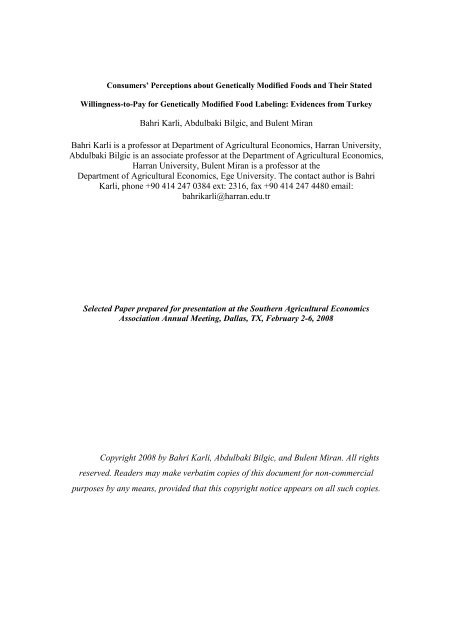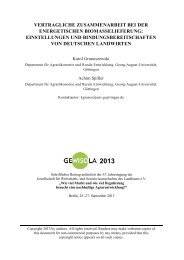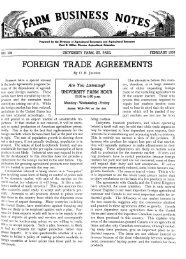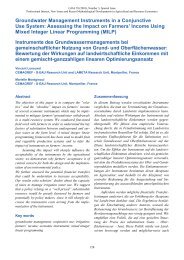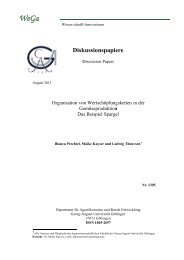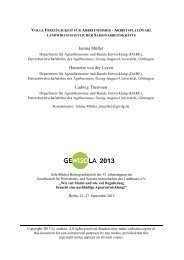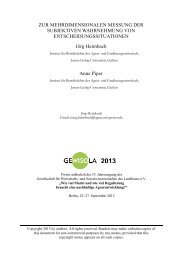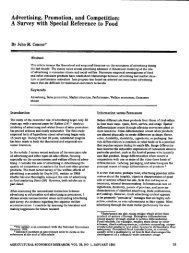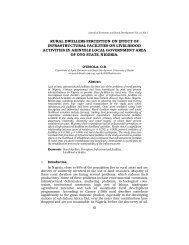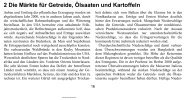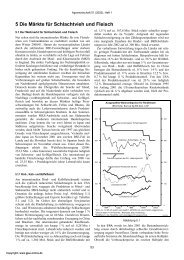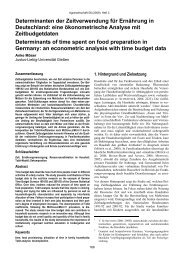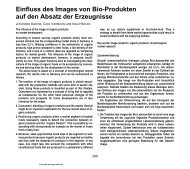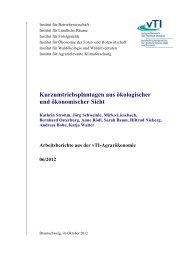Bahri Karli, Abdulbaki Bilgic, and Bulent Miran ... - AgEcon Search
Bahri Karli, Abdulbaki Bilgic, and Bulent Miran ... - AgEcon Search
Bahri Karli, Abdulbaki Bilgic, and Bulent Miran ... - AgEcon Search
You also want an ePaper? Increase the reach of your titles
YUMPU automatically turns print PDFs into web optimized ePapers that Google loves.
Consumers’ Perceptions about Genetically Modified Foods <strong>and</strong> Their Stated<br />
Willingness-to-Pay for Genetically Modified Food Labeling: Evidences from Turkey<br />
<strong>Bahri</strong> <strong>Karli</strong>, <strong>Abdulbaki</strong> <strong>Bilgic</strong>, <strong>and</strong> <strong>Bulent</strong> <strong>Miran</strong><br />
<strong>Bahri</strong> <strong>Karli</strong> is a professor at Department of Agricultural Economics, Harran University,<br />
<strong>Abdulbaki</strong> <strong>Bilgic</strong> is an associate professor at the Department of Agricultural Economics,<br />
Harran University, <strong>Bulent</strong> <strong>Miran</strong> is a professor at the<br />
Department of Agricultural Economics, Ege University. The contact author is <strong>Bahri</strong><br />
<strong>Karli</strong>, phone +90 414 247 0384 ext: 2316, fax +90 414 247 4480 email:<br />
bahrikarli@harran.edu.tr<br />
Selected Paper prepared for presentation at the Southern Agricultural Economics<br />
Association Annual Meeting, Dallas, TX, February 2-6, 2008<br />
Copyright 2008 by <strong>Bahri</strong> <strong>Karli</strong>, <strong>Abdulbaki</strong> <strong>Bilgic</strong>, <strong>and</strong> <strong>Bulent</strong> <strong>Miran</strong>. All rights<br />
reserved. Readers may make verbatim copies of this document for non-commercial<br />
purposes by any means, provided that this copyright notice appears on all such copies.
Consumers’ Perceptions about Genetically Modified Foods <strong>and</strong> Their Stated<br />
Willingness-to-Pay for Genetically Modified Food Labeling: Evidences from Turkey<br />
Abstract<br />
We applied a multinomial logit model to determine consumer characteristics affecting<br />
three possible policy regulations that wanted to be implemented for genetically modified foods in<br />
Turkey. The study reveals that many household characteristics including food spending amount,<br />
education, gender, marital status, knowledge about food related policies <strong>and</strong> regional variables<br />
are key policy factors to choose regulation programs on GMO foods. People are more prone to<br />
implement compulsory policy on GMO foods than that of voluntary policy.<br />
1. Introduction<br />
Genetically modified crops of agriculture for whom so called ‘Frankenstein food’<br />
<strong>and</strong> for whom so called ‘Green golden food’ are becoming increasingly important<br />
nowadays in the world. The application of transgenic or in other words, genetically<br />
modified (GM) technology on agricultural products <strong>and</strong> the resulting genetically<br />
modified organisms (GMO) are considered to be one of the most effective yet<br />
controversial achievements in science <strong>and</strong> technology (Lusk et al., 2002; Kaneko <strong>and</strong><br />
Chern, 2005). Despite all promises <strong>and</strong> benefits proclaimed by many biotech agricultural<br />
based companies <strong>and</strong> the governments such as create its own pesticide usage <strong>and</strong><br />
persistence, higher crop yields, enhanced nourishing values <strong>and</strong> many more, the<br />
controversy surrounding its use to food production widespread to many countries<br />
(Loureiro <strong>and</strong> Hine, 2002; Chern et al., 2003; Huffman, 2003; Kaneko <strong>and</strong> Chern, 2005).<br />
To determine pervasive effects of GM foods on consumers’ perceptions attract<br />
2
scientist especially agricultural economists <strong>and</strong> literature in the topic of consumer<br />
reactions to GM foods devotes considerable applications to determine factors beyond this<br />
food. The studies applied to consumer attitudes <strong>and</strong> perceptions towards GM foods<br />
include stated preference methods of contingent valuation (CV) under r<strong>and</strong>om utility<br />
dem<strong>and</strong> model framework. The effects of consumer socio-demographic factors <strong>and</strong> as<br />
well as food related characteristics including the bid for willingness-to-pay were then<br />
becomingly increasingly analyzed. Many consumers probably want to avoid GM foods<br />
until the uncertain effects of GM foods on human health become obvious <strong>and</strong> clear<br />
(Loureiro <strong>and</strong> Hine, 2002; Lusk et al., 2002; Chern et al., 2003; Huffman, 2003; Rousu et<br />
al., 2004; Kaneko <strong>and</strong> Chern, 2005).<br />
GM <strong>and</strong> non-GM food labeling helps reducing the asymmetric information<br />
problem between producers of GM foods <strong>and</strong> consumers. The problem of asymmetric<br />
information is that the agricultural biotech industries know what exactly inherited in<br />
goods they produce in comparison to consumers who do not really have such<br />
information. However, GM food labeling policies differ from country to country perhaps<br />
due in large part to the greatest challenges for agricultural trade, the World Trade<br />
Organization regulation (WTO), <strong>and</strong> for the producers. There are mainly three types of<br />
labeling schemes: labeling ban, voluntary labeling <strong>and</strong> m<strong>and</strong>atory labeling (Loureiro <strong>and</strong><br />
Hine, 2002; Lusk et al., 2002; Chern et al., 2003; Huffman, 2003; Morgan <strong>and</strong> Goh,<br />
2004; Rousu et al., 2004; Kaneko <strong>and</strong> Chern, 2005; Terawaki, 2005).<br />
Despite GMO foods so called monster foods or Frankenstein foods take a<br />
nationwide market place in Turkey, Turkish consumers do not yet enough have<br />
information about these types of products. This study is aimed to determine the<br />
3
consumers’ perceptions about GM food policy to be implemented <strong>and</strong> their stated<br />
willingness-to-pay for GM foods labeling using contingent valuation method under<br />
r<strong>and</strong>om utility dem<strong>and</strong> model. The effects of consumers’ characteristics on the possible<br />
policy programs for food labeling is then determined. On the other h<strong>and</strong>, to determine if<br />
the perceived knowledge about food related policy that are implemented by many<br />
developed <strong>and</strong> developing countries affect the choice to prone <strong>and</strong> against the GMO<br />
regulation programs.<br />
Nowadays, food safety issue is one of the greatest topic ever for WTO <strong>and</strong> to our<br />
knowledge there is no any pervasive study contacted on Turkish consumers regarding the<br />
effects of their characteristics on GM foods for labeling issue <strong>and</strong> thus the results<br />
obtained from this study are aimed to serve as a political means for solving problems of<br />
Turkey, which faces to adapt the EU regulations for membership under dual negotiation.<br />
In addition, the study helps domestic supermarkets, wholesales <strong>and</strong> as well as<br />
international exporter of GM foods to Turkey to renovate their policy for better<br />
underst<strong>and</strong>ing of consumer preferences in the country.<br />
This study applied data collected from nationwide survey including three<br />
metropolitan cities of seven regions where collected information from about 3,200<br />
Turkish households about their perception on food safety <strong>and</strong> security including different<br />
food labeling scenarios presented to them. This project was supported by The Scientific<br />
<strong>and</strong> Technological Research Council of Turkey.<br />
The model used in this study was based on a choice experiment estimating the<br />
three laws (e.g., compulsory GMO, voluntary GMO <strong>and</strong> non). In the survey, respondents<br />
were asked several questions. In each question, respondents were asked to select a choice<br />
4
etween three alternatives that the government should take into account. Respondents are<br />
faced three choices: either pick up a card indicating compulsory GMO regulation with<br />
European Union, or food with voluntary GMO regulation or none.<br />
2. The Model<br />
We assume that the analyst can not completely observe the household conditional indirect<br />
utility function. As such, the conditional indirect utility model decomposes into two parts:<br />
a deterministic portion <strong>and</strong> a r<strong>and</strong>om portion. This can be illustrated as:<br />
U = V + ε j = 1, 2,3<br />
j j j<br />
The consumer or household will choose GMO policy alternative j if<br />
( ε ) ( ε )<br />
U V + > U V + for all other k ≠ j<br />
j j j k k k<br />
The probability that the household chooses the GMO policy alternative j will be<br />
( V V<br />
≠ )<br />
ϑ = Pr − > θ , ∀<br />
where θ = ε − ε<br />
j j k jk k j<br />
jk k j<br />
V j is not directly observable but we can instead observe which the GMO policy<br />
alternative the household are willing. Define an indicator variable δ j such that δ j = 1 if<br />
the household chooses alternative j <strong>and</strong> 0 otherwise. Then δ j = 1 if<br />
V + ε > V + ε ∀k ≠ j . This can be written as<br />
j j k k<br />
( V V<br />
≠ )<br />
( δ j )<br />
θ = Pr − > θ ∀<br />
j j k jk k j<br />
= Pr = 1<br />
If r<strong>and</strong>om errors are independently <strong>and</strong> identically distributed across specified choices<br />
<strong>and</strong> number of households with a type I extreme value distribution, then the resulting<br />
probability of household i choosing one of given alternatives is simply a multinomial<br />
5
logit model (Greene, 2003). This can be shown as<br />
( δ j = ) = 2<br />
∑<br />
Pr 1<br />
e<br />
k=<br />
0<br />
V j<br />
e<br />
Vk<br />
Following the st<strong>and</strong>ard convention, if we set the parameter estimates for choosing the<br />
alternative that the consumer is not interested in GMO policy at all, the probability in<br />
above equation can be written as<br />
j e<br />
Pr ( δ j = 1) = for j = 2,3<br />
2<br />
Vk<br />
1+<br />
e<br />
k=<br />
1<br />
1<br />
Pr ( δ j = 1) = for j = 1<br />
2<br />
Vk<br />
1+<br />
e<br />
V<br />
∑<br />
∑<br />
k=<br />
1<br />
Marginal effects in this model are<br />
∂ Prj<br />
γ j =<br />
∂x<br />
j = 1,2,3<br />
= Prj<br />
( j − )<br />
where = ∑ Pr<br />
2<br />
k = 0<br />
j j<br />
where j are a set of parameter estimates correspondence to the specified alternatives.<br />
Asympotitc variance-covariance of parameter estimates of marginal effects can be<br />
constructed using the delta method (Greene, 2003).<br />
3. Data<br />
The survey was conducted to examine Turkish people perceptions about genetically<br />
modified foods <strong>and</strong> their stated willingness-to-pay to avoid risk perceptions. Therefore,<br />
data were collected on risk perceptions on GMO foods, knowledge about these products<br />
consumptions, satisfaction with these foods, <strong>and</strong> demographic variables. In addition to<br />
6
several willingness-to-pay questions related to corn flakes <strong>and</strong> oil, respondents were<br />
asked to choose three alternative GMO food policy implications to make sure that their<br />
foods are safe <strong>and</strong> secure. In essence, the respondents were asked to specifically choose<br />
the policy alternative they want to see at regulation.<br />
Data were collected from nationwide survey in 2007 including three metropolitan<br />
cities of 14 provinces where collected information from about 3,200 Turkish households<br />
about their perception on food safety <strong>and</strong> security including different food labeling<br />
scenarios presented to them. This project was supported by The Scientific <strong>and</strong><br />
Technological Research Council of Turkey. In the current study, the final sample<br />
includes 2,411 household observations after the deletion of records with the missing<br />
observations, outliers, or other information relevant to the study. Descriptive statistics of<br />
variables are presented in Table 1. A senior household member was requested to give all<br />
necessary information regarding food safety <strong>and</strong> security that the household consumes.<br />
An average person’s age was 36 <strong>and</strong> total monthly spending on was in expected<br />
range. Interestingly, 85 per cent of individuals want compulsory GMO policy regulation.<br />
This has an intuitive sense that most of people could be well aware of risk contamination<br />
in GMO foods as policy <strong>and</strong> procedures for public notification prevails negative side that<br />
the GMO causes.<br />
The survey sample shows that Turkish person usually has a high school degree<br />
which echoes with national indicators. Family shelters four members. We presented<br />
respondents with 6 international food related policies such as HACCP, ISO 9001,<br />
EUREPGAP, <strong>and</strong> etc whether they know them what exactly they mean. The survey result<br />
shows that respondent does not have well information regarding these policies. Most of<br />
7
espondents are married <strong>and</strong> male. Only approximately 8 per cent of respondents do not<br />
hold security insurances.<br />
4. Results <strong>and</strong> Discussions<br />
The results of initial parameter estimates of multinomial logit model are presented in<br />
Table 2. We include important factors to examine what determines the GMO policy that<br />
could be regulated in the country. European Union requires all shops <strong>and</strong> restaurants to<br />
notify customers about genetically modified ingredients in their food. The log likelihood<br />
ratio test signifies the importance of factors used to identify variation among alternative<br />
decisions.<br />
Focused are marginal effects because initial estimates in the multinomial logit<br />
model do not reflect true unitary impact on the decision to choose GMO alternative<br />
policy. Marginal impacts for the alternative that the individuals are not interested in at all<br />
were discussed first. Increasing food spending reduces the probability of non-GMO<br />
policies, indicating that as food spending increases, people becomes more concerned of<br />
GMO products. Educational attainments have a significant effect on the probability that<br />
the individuals who are not interested in GMO policy regulation. As people earn more<br />
educational level, the support for non-GMO policy becomes less relevant. Index for<br />
knowledge of food related food regulations reduces significantly the probability decision.<br />
This has an intuitive implication, suggesting that as people become more knowledgeable<br />
about food regulated policy, the support for GMO policy regulation becomes prevailing.<br />
Males are less likely to support non-GMO policy than females. Interestingly<br />
employing person desires null alternative. This could be that employed person do not<br />
have enough time to read what exactly the costs <strong>and</strong> benefits of the GMO are.<br />
8
Focusing on factors affecting the compulsory GMO regulation, household<br />
spending on foods had a positive impact on the decision. The more spending on foods,<br />
the more willingness the policy to be compulsorily implemented. This is an expected<br />
result, because more spending means more time to search products <strong>and</strong> ingredients than<br />
people spend less on foods. People become more conservative about what they eat.<br />
Education has a significant <strong>and</strong> positive impact on the compulsory alternative to be<br />
implemented in the nation. Knowledge variable is statistically significant, implying that<br />
consumers, who are more knowledgeable <strong>and</strong> subjective towards GMO products, become<br />
prone of the GMO regulation.<br />
Males are more likely to support this alternative than their counterparts <strong>and</strong><br />
married people are also support this program to be implemented than any other marital<br />
status that people hold. The respondents who have currently jobs are against the<br />
implementation of this program. This echoes with what we found for previous alternative.<br />
Interestingly people residing in metropolitan cities are less likely to support compulsory<br />
program than people residing in elsewhere.<br />
Results are for the last alternative, voluntarily GMO food policy, to be discussed.<br />
Food spending a reflection for purchasing power had interestingly negative impact on this<br />
alternative. This is an expected result because people who spend more become more<br />
sensitive what they indeed eat <strong>and</strong> the ingredients in foods should all be clear to them.<br />
Education had positive <strong>and</strong> significant impact on the decision the program to be<br />
implemented voluntarily, while household size reduces the chance the program to be<br />
implemented voluntarily. Knowledge about food regulated policy makes people less<br />
desire voluntary program to be implemented in the country. This echoes with what we<br />
9
found in two previous alternatives. Married persons are less likely to be prone of<br />
voluntary programs.<br />
5. Conclusions <strong>and</strong> Implications<br />
We conducted a national interviewed survey in Turkey in 2007, asking the senior person<br />
in the household for preferences about possible policy regulation to be implemented on<br />
GMO foods. The results indicate that the Turkish consumers are more prone of<br />
compulsory programs than any other programs. GMO can produce higher yields, create<br />
their own natural pesticides <strong>and</strong> foster more nourishing food--- but on the other h<strong>and</strong>,<br />
critics reveal that these foods have the potential to cause vast damage to the environment<br />
in general <strong>and</strong> human health in particular. The issue strikes a visceral chord across the<br />
world: many European Greenpeace activities have taken to hacking down swaths of these<br />
products <strong>and</strong> more mainstream groups have launched protests across the United States<br />
<strong>and</strong> Europe.<br />
We analyzed factors affecting three possible policy scenarios to be implemented.<br />
Results showed that food spending favors the compulsory programs as people earn more<br />
incomes. However, people with lower <strong>and</strong> medium income may still purchase GMO<br />
products despite their price increase. The benefits <strong>and</strong> costs of the GMO foods should be<br />
explained to people at early age possibly at schools. Consumer group activists take food<br />
regulated policies such as HACCP <strong>and</strong> ISO 9001 to inform consumers about whey they<br />
imply for. Male <strong>and</strong> married people should be well informed about the GMO while they<br />
are shopping, eating at restaurants.<br />
10
References<br />
Greene, W. H (2000). Econometric Analysis. Prentice Hall, Upper Saddle River, NJ.<br />
Huffman, W. E., (2003). “Consumers’ Acceptance of (<strong>and</strong> Resistance to) Genetically<br />
Modified Foods in High-Income Countries: Effects of Labels <strong>and</strong> Information in<br />
an Uncertain Environment.” American Journal of Agricultural Economics 85:<br />
1112-1118.<br />
Kaneko, N., <strong>and</strong> W. S. Chern (2005). “Consumer Acceptance of Genetically Modified<br />
Foods in Taiwan: Is Positive Discount the Same as Negative Premium?” Selected<br />
Paper Prepared for Presentation at the American Agricultural Economics<br />
Association Annual Meeting, Providence, Rhode Isl<strong>and</strong>, July 24 -27, 2005.<br />
Loureiro, M. L., <strong>and</strong> S. Hine (2002). “Discovering Niche Markets: A Comparison of<br />
Consumer Willingness to Pay for Local GMO-Free Products.” Journal of<br />
Agricultural <strong>and</strong> Applied Economics 34: 477-487.<br />
Lusk, L. J., M. Moore, L. O. House, <strong>and</strong> B. Morrow (2002) “Influence of Br<strong>and</strong> Name<br />
<strong>and</strong> Type of Modification on Consumer Acceptance of Genetically Engineered<br />
Corn Chips: A Preliminary Analysis” International Food <strong>and</strong> Agribusiness<br />
Management Review 4: 373-383.<br />
Morgan, R., <strong>and</strong> G. Goh (2004). “Genetically Modified Food Labelling <strong>and</strong> the WTO<br />
Agreements.” RECIEL 13: 306-319.<br />
Rousu, M. C., W. E. Huffman, J. F. Shogren, <strong>and</strong> A. Tegene (2004). “Estimating the<br />
Public Value of Conflicting Information: The Case of Genetically Modified<br />
Foods.” L<strong>and</strong> Economics 80: 125- 135.<br />
11
Terawaki, T. (2005). “Effects of Information on Consumer Risk Perception <strong>and</strong><br />
Willingness to Pay for Non-Genetically Modified Corn Oil.” Selected Paper<br />
Prepared for Presentation at the American Agricultural Economics Association<br />
Annual Meeting, Providence, Rhode Isl<strong>and</strong>, July 24-27, 2005.<br />
12
Table 1: Descriptive Statistics of variables<br />
Variable Descriptions Mean Std<br />
Y0 1 if the respondent chooses is not interested in GMO policies, 0 otherwise<br />
.08503<br />
.2790<br />
Y1<br />
Y2<br />
Hfoods<br />
Age<br />
Educatn<br />
Hsize<br />
Knowindx<br />
Gender<br />
Msatusm<br />
Emplogy<br />
Security<br />
Cdisease<br />
Mcities<br />
1 if the respondent chooses compulsory GMO policy, 0 otherwise<br />
1 if the respondent chooses voluntary GMO policy, 0 otherwise<br />
Monthly food spending amounts in New Turkish Liras<br />
Age of the respondent in years<br />
The respondent education levels in years<br />
Number of household size<br />
An index created from food policies such as HACCP utilizing whether the<br />
respondent knows this policy or not<br />
1 if the respondent is male, 0 otherwise<br />
1 if the respondent is married, 0 otherwise<br />
1 if the respondent is currently employed, 0 otherwise<br />
1 if the respondent does not have a social security, 0 otherwise<br />
1 if the household has at least one member with chronic disease, 0 otherwise<br />
1 if the households resides either in Istanbul, or Ankara or Izmir<br />
.8457<br />
.0693<br />
470.881<br />
36.3156<br />
13.0877<br />
3.5157<br />
2.6470<br />
.6080<br />
.6802<br />
.7860<br />
.0755<br />
.1659<br />
.5732<br />
.3613<br />
.2540<br />
299.192<br />
10.5746<br />
3.4713<br />
1.4934<br />
1.3531<br />
.4883<br />
.4665<br />
.4102<br />
.2642<br />
.3721<br />
.4947<br />
13
Table 2: Maximum Likelihood Parameter Estimates of Multinomial Logit Model<br />
Variable<br />
Y=1 Y=2<br />
Estimate t-value Estimate t-value<br />
Constant<br />
-.8645 -1.616 -1.0279 -1.409<br />
Hfoods<br />
Age<br />
Educatn<br />
Hsize<br />
Knowindx<br />
Gender<br />
Msatusm<br />
Employg<br />
Security<br />
Cdiseas<br />
Mcities<br />
Log-likelihood<br />
Restricted Log-likelihood<br />
Chi Squared with 22 df<br />
.0009 a<br />
-.0054<br />
.1827 a<br />
.0676<br />
.2778 a<br />
.4357 a<br />
-.0067<br />
-.3395 b<br />
-.1455<br />
.1905<br />
-.2009<br />
2.634<br />
-.644<br />
7.455<br />
1.236<br />
4.588<br />
2.533<br />
-.035<br />
-1.654<br />
-.577<br />
.881<br />
-1.206<br />
-1179.369<br />
-1,292.838<br />
226.938<br />
-.0003<br />
-.0113<br />
.1087 a<br />
.1569 a<br />
.0411<br />
.2214<br />
-.5471 a<br />
-.1333<br />
-.2466<br />
.1757<br />
-.4063 b<br />
Note: a, b represent statistically significant levels at 0.05 <strong>and</strong> 0.10 percent respectively.<br />
-.566<br />
-.962<br />
3.170<br />
2.265<br />
.492<br />
.943<br />
-2.105<br />
-.475<br />
-.695<br />
.606<br />
-1.774<br />
14
Table 3: Marginal Effects of GMO Policy Alternatives<br />
Variable<br />
Y=0 Y=1 Y=2<br />
Estimate t-value Estimate t-value Estimate t-value<br />
Constant .0521 a<br />
1.662 -.0395 -.875 -.0126 -.389<br />
Hfoods<br />
Age<br />
Educatn<br />
Hsize<br />
Knowindx<br />
Gender<br />
Msatusm<br />
Employg<br />
Security<br />
Cdiseas<br />
Mcities<br />
-.0001 a<br />
.0003<br />
-.0106 a<br />
-.0044<br />
-.0156 a<br />
-.0251 a<br />
.0025<br />
.0194 a<br />
.0090<br />
-.0113<br />
.0127<br />
-2.463<br />
.694<br />
-7.408<br />
-1.349<br />
-4.416<br />
-2.486<br />
.217<br />
1.606<br />
.607<br />
-.883<br />
1.297<br />
.0001 a<br />
.00002<br />
.0141 a<br />
-.0010<br />
.0280 a<br />
.0356 a<br />
.0282 a<br />
-.0298 a<br />
-.0027<br />
.0114<br />
-.0003<br />
4.042<br />
.024<br />
6.755<br />
-.228<br />
5.577<br />
2.515<br />
1.791<br />
-1.738<br />
-.123<br />
.645<br />
-.023<br />
-.0001 a<br />
-.0004<br />
-.0035 a<br />
.0053 a<br />
-.0124 a<br />
-.0105<br />
-.0307 a<br />
.0104<br />
-.0063<br />
-.0001<br />
-.0124<br />
-3.092<br />
-.677<br />
-2.286<br />
1.905<br />
-3.426<br />
-1.034<br />
-2.767<br />
.846<br />
-.385<br />
-.009<br />
-1.245<br />
Note: a, b represent statistically significant levels at 0.05 <strong>and</strong> 0.10 percent respectively.<br />
15


